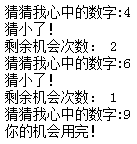程序设定一个数字,用户输入一个数字,判断是否猜对。
temp=input("猜猜我心中的数字:")
guess=int(temp)
if guess==8:
print("猜对!")
else:
print("猜错了!")
print("游戏结束!")###运行结果:
上一个程序中,用户猜错要重新运行程序,嵌套while循环让用户可以一直猜,知道猜对。另外,系统设定的数字不能是静态的,要改为随机生成。
#改进 import random temp = input("猜猜我心中的数字:") guess=int(temp) secret=random.randint(1,10) while guess!=secret: if (guess<secret): print("猜小了!") else: print("猜大了!") temp=input("猜猜我心中的数字:") guess = int(temp) print("猜对!游戏结束!")
###运行结果:
现在,用户只能有三次机会来猜数字。我们可以修改循环的条件,当用户没猜中并且机会还没用完,就一直执行这个循环体。
import random temp = input("猜猜我心中的数字:") guess = int(temp) secret = random.randint(1,10) i = 2 while (guess!=secret)and(i): if (guess < secret): print("猜小了!") print("剩余机会次数:",i) else: print("猜大了!") print("剩余机会次数:", i)
temp = input("猜猜我心中的数字:")
guess = int(temp)
i = i - 1else:
if(i>0):
print("猜对!游戏结束!")
else:
print("你的机会用完!")
###运行结果:

## 4. 总结一下要点
* 在 python 中,while … else 在循环条件为 false 时执行 else 语句块。
* Python中的and逻辑运算操作符可以将任意表达式连接在一起,并得到一个布尔类型的值。原文:http://blog.51cto.com/13820241/2131519